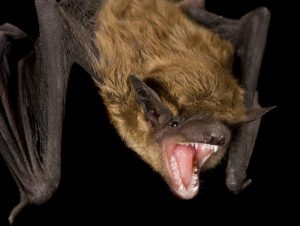Sonar – Part 3
 Last month, we discussed the incredible precision of bat echolocation. I want to talk just a bit more about these amazing nocturnal flyers that “see” by listening to echoes. If you look up into the sky on a warm summer evening you will likely see many bats flitting about. How do they distinguish their echo from the sound of other bats? Big browns (right) will change their screech frequency to be different from other bats in the area or they will aim their sound away from other bats to explore a different part of the sky. But this doesn’t work when Mexican freetails come flying out of a cave opening by the millions. It seems those bats fly through the complete darkness of the cave by memory. This explains why they will absurdly bang straight into a cave door that was newly installed. The greater horseshoe bat can tell if an insect is flying towards them or away from them. It uses an especially long pulse that returns a louder echo when the insect wing is perpendicular. They can even determine the species of insect by the echo! Certain moth varieties produce their own clicks that sound mimic the hunting bat. This “jams” the bat’s sonar. The Mediterranean long-fingered bat uses its sonar to scrutinize the waters of lagoons. These bats capture fish by echolocating for ripples left as the fish come to the surface to feed. We don’t have enough time to discuss all the wonders of bats echolocation. Bats in the Bible are only mentioned in a negative light, as unclean creatures that are not to be eaten (Leviticus 11:19 and Deuteronomy 14:18). Our recent experience with the covid pandemic reinforces the wisdom of this divine command to the ancient Jews!
Last month, we discussed the incredible precision of bat echolocation. I want to talk just a bit more about these amazing nocturnal flyers that “see” by listening to echoes. If you look up into the sky on a warm summer evening you will likely see many bats flitting about. How do they distinguish their echo from the sound of other bats? Big browns (right) will change their screech frequency to be different from other bats in the area or they will aim their sound away from other bats to explore a different part of the sky. But this doesn’t work when Mexican freetails come flying out of a cave opening by the millions. It seems those bats fly through the complete darkness of the cave by memory. This explains why they will absurdly bang straight into a cave door that was newly installed. The greater horseshoe bat can tell if an insect is flying towards them or away from them. It uses an especially long pulse that returns a louder echo when the insect wing is perpendicular. They can even determine the species of insect by the echo! Certain moth varieties produce their own clicks that sound mimic the hunting bat. This “jams” the bat’s sonar. The Mediterranean long-fingered bat uses its sonar to scrutinize the waters of lagoons. These bats capture fish by echolocating for ripples left as the fish come to the surface to feed. We don’t have enough time to discuss all the wonders of bats echolocation. Bats in the Bible are only mentioned in a negative light, as unclean creatures that are not to be eaten (Leviticus 11:19 and Deuteronomy 14:18). Our recent experience with the covid pandemic reinforces the wisdom of this divine command to the ancient Jews!
Posted on January 1, 2023 by dwoetzel.
